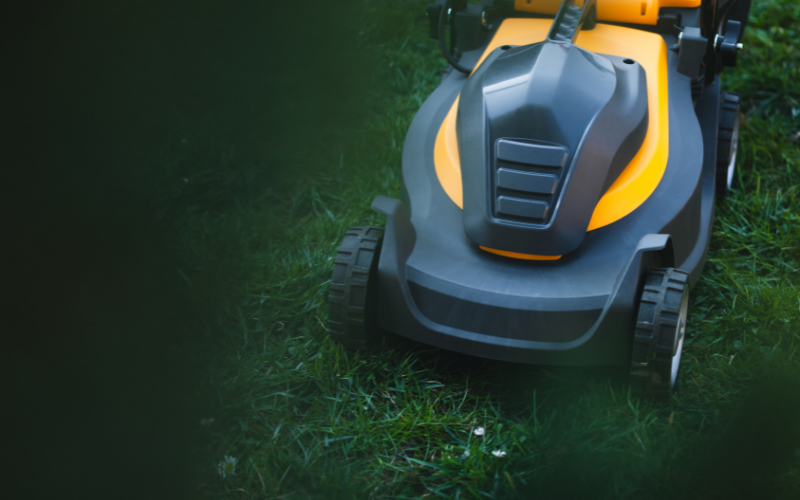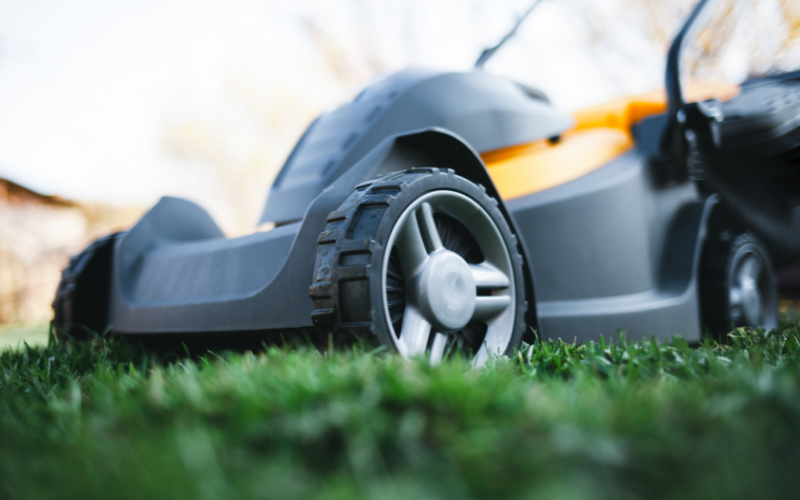Powering everything from toothbrushes to elevators, you can find electric motors everywhere. And if you’ve been around the world of electric motors or tools at all, you have probably heard the terms brushless and brushed when talking about them.
Electric push mowers come with either brushed and brushless motors. In the past the majority of these mowers have been made with brushed electric motors, but newer brushless technology has become more popular lately.
Because of this, many people have been left to wonder, what is a brushless lawn mower? and, what does a brushless motor mean for a mower?
What is a Brushless Lawn Mower?
A brushless lawn mower is an electric push mower that uses a brushless motor and a battery to operate.
As the name suggests, brushless motors are designed to run without the use of brushes to provide electricity to them.
Some electric push mowers use a brushed motor which is why the distinction is important.
How Does a Brushless Mower Work?
To talk about how a brushless mower works you need to talk about its motor.
A brushless motor has two main parts: a permanent magnet that rotates at its center, and a coil that surrounds the magnet.
The permanent magnet is a magnet with fixed magnetism (like a fridge magnet), and the coil is made from a bunch of copper windings.
Brushless motors use external wiring and a sensor to deliver electricity to the coils correctly. This clever use of magnets and electrical timing allows brushless motors to work very efficiently.
On the other hand, a brushed motor is made from similar parts but its coil rotates on the inside of a permanent magnet instead.
This complicates things for brushed motors because it means that electricity needs to be delivered to the spinning part. This is what brushes are used for.
Brushes are spring loaded conductors that are pushed into contact with a commutator as it spins. Due to friction here, brushes tend to get worn out over time.
The Advantages of a Brushless Lawn Mower
Brushless motors are a bit more complex to build than brushed motors, but their design offers a number of advantages.
Let’s take a look at some of the most relevant ones:
Efficient Battery Use
With the right battery, a brushless lawn mower can tackle bigger yards. This is because no energy is lost between the rotating magnet and its surrounding coil due to friction.
Battery power in brushless mowers is stretched as far as possible because of this.
Quieter Mowing
If your lawn mower uses a brushless motor you’ll no longer need to worry about getting nasty looks from your neighbors while mowing in the early morning.
Without brushes and their added friction to the motor, brushless motors run extremely quietly. Though you won’t escape the noise of your blades cutting grass, brushless lawn mowers create a lot less sound.
Increased Power
Brushless motors are really powerful and can handle more demanding loads without lagging. The reason for this is because of where the coil is placed in the motor.
Sitting on the outside of the magnet that spins, it is possible to wrap more wire and increase the size of the coil which also increases torque.
Less Maintenance
There is less maintenance required for brushless lawn mowers because their motors don’t use brushes.
This means that the motor is more reliable and doesn’t require the upkeep of cleaning and replacing brushes.
Adaptable Power Use
The electronic sensors that brushless motors use act as a management system for how hard the motor works.
By only using the exact amount of energy required, none is wasted and battery life is optimized.
Harder to Overheat
Though there is still some heat produced by brushless motors, there is a whole lot less than motors that use brushes and friction.
Also, since the coils in brushless motors are on the outside edge of the motor, it is easier for them to cool as the motor runs.
Brushless vs Brushed Lawn Mower
The debate surrounding whether to buy a brushless vs brushed lawn mower can usually be decided by looking at a handful of good points of comparison.
I think that the best way to compare the two is to look at these factors:
Efficiency
In general, brushless motors typically operate with about 80-90% efficiency whereas brushed motors operate with about 60-75% efficiency.
Not all brushed or brushless motors are equal, but brushless motors are without a doubt more efficient because of their design.
Cost
There is a huge range of prices when it comes to cordless electric push mowers, but there is a trend that always holds true: brushless lawn mowers are more expensive.
Brushless motors are more complicated to build and run so they tend to increase the price of mowers that use them.
Maintenance
The presence or absence of those pesky little brushes makes all the difference here.
Brushless motors require extremely little maintenance over the span of their use. However, brushless motors are much more difficult to service because of their complicated design.
Brushed mowers are the opposite. They require maintenance at regular intervals, (usually because of the brushes) but are more simple to work with.
With that being said, brushless motors on average last 5-10 times longer than brushed motors without maintenance.
Final Thoughts
Maybe you were just curious about the term, or maybe you are on the hunt for a new mower. Whatever the case, there are a couple of clear takeaways:
Because of their motor design and conservative use of electricity, brushless lawn mowers are quiet, durable, and can produce the most power for the longest amount of time.
When it comes to comparing brushed vs brushless lawn mowers, there is a clear winner: brushless lawn mowers.




Hi. Great article! I have a Powersmith I bought for 100 dollars. No batteries. The battery’s are a hundred bucks each. 60 on Amazon aftermarket. I’m a techie so I’m trying to make an outboard battery, which I’ve done. My question is are the 2 batteries connected in series as it appears they are to create 80 volts to power the module, and that powers the 40 volt motor. Or is it an 80 volt 3 phase motor? Haven’t hooked up the battery yet. I think it’s actually an 80 volt motor with a 40 volt nameplate maybe for safety rating?? Anyway thanks for any advice you may have to offer. Mike Retz
Hey Mike,
Thank you! I know the Powersmith model you’re talking about, but can’t say that I have any firsthand experience with it. My guess is that you’re right that the batteries work together to put out 80 volts. It seems like a heavier duty mower so I would assume it cranks out more than 40 volts.
Sounds like you’re in for a pretty fun project! I’ve never made an outboard battery before. If I were you, I’d probably shoot Powersmith an email or a call to try and get some manufacturer-direct information. Would be a bummer to get elbow deep into it before knowing for sure. Hope it works out for you!
Tom.
Can brushless mowers be corded, or does that only apply to battery mowers ?
Hi Steve 🙂
Great question! Technically corded electric tools can be made with brushless motors, but it isn’t very common. I think the reason for this is because brushless motors are designed to be able to produce a ton of power without needing to be connected to an unlimited power supply.
As far as lawn mowers go I’ve never seen a brushless corded electric mower before.
Cheers, Tom.
Thank you so much for your easily understood explanation and comparison of brushless vs brush motor lawn mowers.
I’m glad that you found it useful, Julee 🙂 Thanks for stopping by and leaving a comment.
Tom.
Thanks for the great explanation Tom. As far as “adaptable power use,” my Ryobi brushless mower seems to kick in extra power after the fact when hitting thick grass, and then there is a short lull in power immediately after. So the best thing for me to do is just stop, wait for the motor to finish it’s pesky cycle, and then start pushing again but go slower to make sure it doesn’t try to power up again. Can anything be done about this?
Hi Jason,
The Ryobi load-sensing technology does a good job of saving battery life by slowing the motor speed when full power isn’t needed, but it can be frustrating for the operator. Unfortunately, there doesn’t seem to be any way to disable the feature. The waiting method seems to be what most people do to overcome the lag in the motor reacting to the lawn.
I have heard that some people raise the deck and cut the lawn twice, but I’m sure you’ll agree this doesn’t make much sense. So, I guess you’re stuck with the new technology.
Good luck cutting.
Tom.